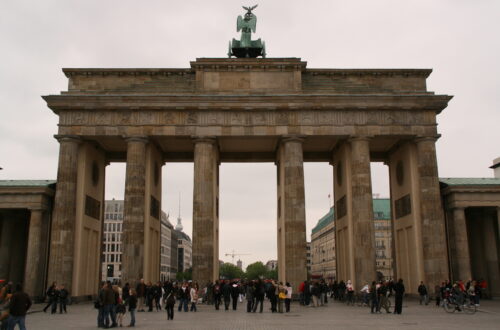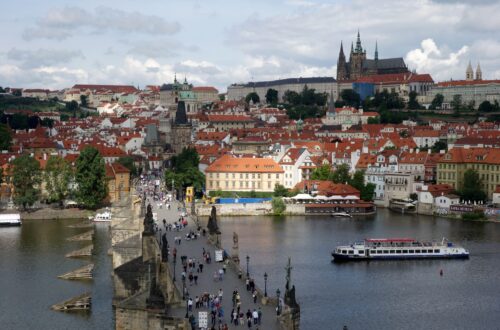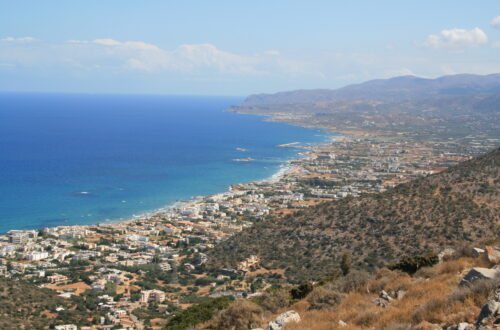
Rome & Tuscany, Italy
Itinerary: Rome – Castiglione del Lago – Siena – Montepulciano – the Chianti region – Firenze – San Gimignano – Bracciano
Rome
Around 2:30 p.m. we arrive at Leonardo da Vinci International Airport in Fiumicino, near Rome. In two weeks we are going to visit Rome and do a road trip in Tuscany. From the airport we take the train to Roma Termini, the main train station of Rome. With the ‘Leonardo Express’ that’s a half-hour ride. Our hostel is within walking distance of Termini, housed in an inconspicuous building, behind a heavy door and in a kind of courtyard, where it is remarkably quiet for a location in the middle of a large, buzzing city.
When we walk into town, we pass the Porta Maggiore, one of the old city gates, and the old city wall. Not much is left of that wall, which is to say that the modern city is built all around, against and over it. We are only out to have dinner, we will do the sightseeing the next day.
This we start with a visit to the Colosseum. This ancient amphitheater (originally called the Flavian Amphitheater) is an impressive structure and arguably the most visited site in Rome. Tour coaches come and go and there is a long line of people waiting at the entrance. We admire the building from the outside and decide to come back a little earlier the next day to avoid the quieus.
Next we head for the Roman Forum, or what is left of it. Of what was once the political and religious center of the great Roman Empire, now only foundations remain and only a few pillars and a triumphal arch remain. New excavations are still being made every day. Nevertheless they are very photogenic ruins. We walk past them down the Via Sacra, the old road that runs right across the Forum.
After the Forum we walk to Piazza Venezia, a busy square with a lot of traffic. On one side is the inescapable Monumento Vittorio Emanuelle, a large white-marble building, built in honor of the unification of Italy. We climb up and once at the op you have a nice view over Piazza Venezia on one side and the Forum and the Colosseum on the other.
After lunch we walk along the back of the Monumento, past the statues of Castor and Pollux, towards the Palazzo Senatorio. Here you have a beautiful view over the Forum, with the Colosseum in the background. Then we walk towards the river Tiber and along the Ponte Fabriccio, one of the oldest surviving bridges in Rome. We arrive at Piazza dei Fiori, a nice square with terraces and a daily vegetable and flower market. A little further on is Piazza Navona, which is not only bigger, but also more beautiful and busier. Like almost all squares and squares in Rome, Piazza Navona is also graced by two large fountains (if a square does not have a fountain, there is an obelisk).
Finally, we arrive at the Panthéon. This large, stately building has the largest dome structure ever built and, especially cosidering the time in which it was built, it’s a fine pieve of historic architecture. The only light that comes in enters through a large hole at the top of the dome, which has a diameter of no less than nine meters.
The next morning we visit the Colosseum, before the coaches with all the tourists arrive. No long lines this time. The amphitheater is as impressive on the inside as it is from the outside. With a little imagination you can see the images of a packed arena, where gladiator fights take place, like in the classic movie ‘Ben Hur’ and the more recent ‘Gladiator’.
After looking around for a while, we walk to the Fontana di Trevi, another tourist-dominated place. The same goes for the ‘Spanish steps’. From there we take the metro towards the independent city state of Vatican City and visit the world famous Piazza San Pietro with the great basilica and the impressive colonnade on either side of the square.
On our last day in Rome we take the metro to Piazza del Popolo. From this square on the north side of the city center you can look down the entire Via Corso up to the Monumento Vittorio Emanuelle. The square itself is quite large, the obelisk in the center has been boxed up for renovation. Up the stairs on the east side of the square is a slightly higher elevated square, called Pincio. From here you look over much of Rome, with the Basilica San Pietro in the background. A nive place with a great view.
Rome is interesting to visit for two reasons: if you are interested in the ancient Roman Empire (Colosseum, Forum, Panthéon) or if you are interested in churches, because if there’s one thing that Rome has a lot, it’s churches. And scooters of course (an extremely convenient mode of transport in such a busy city). On the other hand, in my opinion Rome is not really a city where you easily feel at home. It is a large, busy city with a lot of traffic and many unattractive streets and neighborhoods. Outside the areas where the tourist attractions are, it is quiet and deserted, especially on Sundays. The highlights are definitely worth it, but as a city, to me Rome is less appealing than many other European cities.
Castiglione del Lago and Siena
Just after noon the next day, we pick up our rental car, a new Fiat Panda, and head out of Rome on Autostrada 1. The plan is to drive in one go to Castiglione del Lago, a small town on the edge of Umbria and Tuscany, on Lago di Trasimeno. When we arrive here, we take a look around the walled town and then check in at the camping just outside the town and right on the lake.
The next morning we visit Siena. This historic town is an hour’s drive from Castiglione del Lago. Siena is actually one big tourist attraction. Old streets, squares, churches and old buildings abound. The most beautiful one, in my opinion, is Piazza del Campo, a large, semi-circular square that slopes towards the center and therefore has a bit the shape of a bowl. Surrounding the square are numerous terraces and on the right side of the square is the Palazzo Pubblico with the Torre del Mangia, a tall bell tower. After we’ve seen enough of Siena and are done with all the tourists, we drive back to Castiglione del Lago.
Montepulciano and the Chianti region
The mountain town of Montepulcianois a half hour drive from Castiglione del Lago and built on top of a narrow cliff. Montepulciano is only a small village, but even within the defense walls there is still quite a difference in elevation. We walk down the picturesque streets, until we arrive at Piazza del Domo. Montepulciano is much quieter than Siena and although Siena of course has the beautiful Piazza del Campo, Montepulciano as a whole is a more attractive town. From the tower of the Palazzo del Popolo you have a panoramic view over the area.
After Montepulciano we drive north, into the Chianti region. Chianti is of course known for its wine and soon the Tuscan hills around us are dotted with vineyards. The environment here is really beautiful, endless hills with olive trees and vineyards, interspersed with small villages and towns on top of the hills. Our destination is the town of Castellina in Chianti, but there appears to be no tourist information and (more importantly) no campsite. The same goes for the town of Greve in Chianti, a little further away.
The village of Marcialla, fifteen kilometers to the northwest, does have a campsite. The road from Greve to Marcialla is a local road, which leads up and down the hills, with a number of hairpin bends. Every bend offers new vistas of the Tuscan landscape.
The next day we have only one goal: to tour and enjoy the Tuscan landscape. From Marcialla we first drive back the way we came. A winding, but beautiful route along vineyards and olive trees. In Greve we park the car and walk around a bit. Greve has a nice central triangular square (unfortunately marred by a market). From Greve we choose a local road through the heart of Chianti, past small unknown villages such as Lucolena, Torsoli and Volpaïa, to Radda in Chianti.
The weather is beutiful and we stop regularly to take pictures along the way. We also make two stops at local wineries. Via Castellina in Chianti (another tiny village on a hill) we eventually drive back to Marcialla, where we open a nice bottle of Chianti. Of course.
Firenze
In Firenze (also called Florence), it’s cloudy and a lot colder than the past few days. According to our travel guide and many people around the world, Firenze is the most beautiful city in Italy. We park our car in Piazza Michelangelo, on the south bank of the river Arno, which flows right through the heart of the city. From this slightly elevated parking lot you have a beautiful view over the city, with the Ponte Vecchio and the dome of the Duomo as eye-catchers.
We walk along the river towards the Ponte Vecchio, the thirteenth century bridge with shops on both sides. Today, these are almost all shops that sell cheap jewellery. A pity. On the other side of the Arno is the Uffizi, one of the most important museums in Florence. We are not really fans of Renaissance art, so don’t visit the museum. On the other side of the Uffizi is Piazza della Signoria, a large square with the Palazzo Vecchio as the main eye-catcher. But the term ‘eye-catcher’ is most appropriate for the Duomo, a huge cathedral, built of white, red and green marble, which, in my opinion, makes the duomo a bit kitschy.
Firenze is teeming with tourists, but then again, the city is one of Italy’s main tourist attractions. Most people come here for the museums (the Uffizi and the Accademia, which is home to Michelangelo’s David), but apart from the art and culture, Florence isn’t really a pretty or attractive city. On the contrary, after Rome, Siena and Montepulciano, to me, Firenze is a bit disappointing as a city. Sorry people.
San Gimignano
It’s a cloudy morning again when we drive to San Gimignano. We again opt for the back roads, which wind over the Tuscan hills, through small villages, offering beautiful panoramas along the way. The smaller the road (sometimes even unpaved), the better the views. When we arrive in San Gimignano, it starts to rain. We pop into a cafe for coffee and to wait until the shower has passed. When it has, the sun comes out. We’re lucky.
San Gimignano is a beautiful town. Most characteristic are not so much the three city gates, the old buildings or the nice streets (in that respect San Gimignano is a bit like Montepulciano), but the seven towers that dominate the ‘skyline’ of San Gimignano. Everywhere you walk, you see the towers around you. Besides Montepulciano, in my opinion San Gimignano is the nicest town in Tuscany that we have visited.
The next morning we drive to Volterra. This town is not very noteworthy (even though it is beautifully situated on top of a hill) and the same goes for the road from Volterra to Massa Maritima. According to the Rough Guide this is a nice route through a beautiful part of Tuscany, but after everything we’ve already seen (the area around Montepulciano and Siena and the Chianti region) we think this part of Tuscany is relatively boring. Lots of wooded hills.
The coast and Bracciano
Frtom Massa Maritima we drive to the coast. We find a campsite in Le Rochette, a small coastal town southwest of Grosetto. Here we set up our tent and take some rest, not knowing yet that thunderstorms are heading our way. That night it rains and the weather is no better in the morning. We head south, hoping the weather will be a bit better there.
We leave Tuscany behind and enter Lazio. It rains almost non-stop along the way. Our destination is Lago di Bracciano, an hour’s drive from Rome. We pitch our tent at camping Porticciolo, on Lake Bracciano. The weather is indeed a bit better here and in the afternoon the sun actually comes out. The next day we take a look at the village of Bracciano. It’s nothing special and hardly attracts tourists (except for the campsites on the lake). The castle on the edge of the village, which overlooks the lake, is actually Bracciano’s only attraction.
The last day of the trip we spend relaxing, reading, eating and enjoying some Tuscan wine. Then it’s time to drive from Bracciano to Fiumicino. We drop off our rental car and then the wait for the return flight to the Netherlands begins. All in all it was a nice trip. We had great weather for the most part, Rome was well worth a visit and Tuscany is really beautiful.




